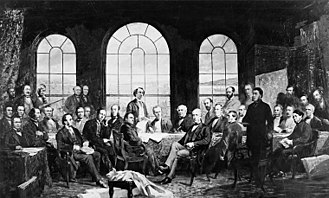| 10 provinces |
| 1 |
| Canada is a federation composed of ten provinces and three territories. In turn, these may be grouped into four main regions: Western Canada, Central Canada, Atlantic Canada, and Northern Canada ("Eastern Canada" refers to Central Canada and Atlantic Canada together). Provinces have more autonomy than territories, having responsibility for social programs such as health care, education, and welfare. Together, the provinces collect more revenue than the federal government, an almost unique structure among federations in the world. Using its spending powers, the federal government can initiate national policies in provincial areas, such as the Canada Health Act; the provinces can opt out of these, but rarely do so in practice. Equalization payments are made by the federal government to ensure that reasonably uniform standards of services and taxation are kept between the richer and poorer provinces. GEography
Canada occupies a major northern portion of North America, sharing land borders with the contiguous United States to the south (the longest border between two countries in the world) and the US state of Alaska to the northwest. Canada stretches from the Atlantic Ocean in the east to the Pacific Ocean in the west; to the north lies the Arctic Ocean. Greenland is to the northeast, while Saint Pierre and Miquelon is south of Newfoundland. By total area (including its waters), Canada is the second-largest country in the world, after Russia. By land area alone, Canada ranks fourth. The country lies between latitudes 41° and 84°N, and longitudes 52° and 141°W.
Since 1925, Canada has claimed the portion of the Arctic between 60° and 141°W longitude, but this claim is not universally recognized. Canada is home to the world's northernmost settlement, Canadian Forces Station Alert, on the northern tip of Ellesmere Island – latitude 82.5°N – which lies 817 kilometres (508 mi) from the North Pole. Much of the Canadian Arctic is covered by ice and permafrost. Canada has the longest coastline in the world, with a total length of 202,080 kilometres (125,570 mi); additionally, its border with the United States is the world's longest land border, stretching 8,891 kilometres (5,525 mi).
Since the end of the last glacial period, Canada has consisted of eight distinct forest regions, including extensive boreal forest on the Canadian Shield. Canada has around 31,700 large lakes, more than any other country, containing much of the world's fresh water. There are also fresh-water glaciers in the Canadian Rockies and the Coast Mountains. Canada is geologically active, having many earthquakes and potentially active volcanoes, notably Mount Meager, Mount Garibaldi,Mount Cayley, and the Mount Edziza volcanic complex. The volcanic eruption of the Tseax Cone in 1775 was among Canada's worst natural disasters, killing 2,000 Nisga'a people and destroying their village in the Nass River valley of northern British Columbia. The eruption produced a 22.5-kilometre (14.0 mi) lava flow, and, according to Nisga'a legend, blocked the flow of the Nass River.
Canada's population density, at 3.3 inhabitants per square kilometre (8.5 /sq mi), is among the lowest in the world. The most densely populated part of the country is the Quebec City – Windsor Corridor, situated in Southern Quebec and Southern Ontario along the Great Lakes and the St. Lawrence River.
Average winter and summer high temperatures across Canada vary from region to region. Winters can be harsh in many parts of the country, particularly in the interior and Prairie provinces, which experience a continental climate, where daily average temperatures are near −15 °C (5 °F), but can drop below −40 °C (−40 °F) with severe wind chills. In noncoastal regions, snow can cover the ground for almost six months of the year, while in parts of the north snow can persist year-round. Coastal British Columbia has a temperate climate, with a mild and rainy winter. On the east and west coasts, average high temperatures are generally in the low 20s °C (70s °F), while between the coasts, the average summer high temperature ranges from 25 to 30 °C (77 to 86 °F), with temperatures in some interior locations occasionally exceeding 40 °C (104 °F).
Flags of Ten Provinces
& 3 Territories of CANADA
The following is a list of Canada's provinces and territories, ranked in order of the 2008 population. Capital cities and area have been included for reference.
Canada's Provinces
1) Ontario
• Population: 12,892,787
• Capital: Toronto
• Area: 415,598 square miles (1,076,395 sq km)
2) Quebec
• Population: 7,744,530
• Capital: Quebec City
• Area: 595,391 square miles (1,542,056 sq km)
3) British Columbia
• Population: 4,428,356
• Capital: Victoria
• Area: 364,764 square miles (944,735 sq km)
4) Alberta
• Population: 3,512,368
• Capital: Edmonton
• Area: 255,540 square miles (661,848 sq km)
5) Manitoba
• Population: 1,196,291
• Capital: Winnipeg
• Area: 250,115 square miles (647,797 sq km)
6) Saskatchewan
• Population: 1,010,146
• Capital: Regina
• Area: 251,366 square miles (651,036 sq km)
7) Nova Scotia
• Population: 935,962
• Capital: Halifax
• Area: 21,345 square miles (55,284 sq km)
8) New Brunswick
• Population: 751,527
• Capital: Fredericton
• Area: 28,150 square miles (72,908 sq km)
9) Newfoundland and Labrador
• Population: 508,270
• Capital: St. John's
• Area: 156,453 square miles (405,212 sq km)
10) Prince Edward Island
• Population: 139,407
• Capital: Charlottetown
• Area: 2,185 square miles (5,660 sq km)
Canada's Territories
1) Northwest Territories
• Population: 42,514
• Capital: Yellowknife
• Area: 519,734 square miles (1,346,106 sq km)
2) Yukon
• Population: 31,530
• Capital: Whitehorse
• Area: 186,272 square miles (482,443 sq km)
3) Nunavut
• Population: 31,152
• Capital: Iqaluit
• Area: 808,185 square miles (2,093,190 sq km)
|


















